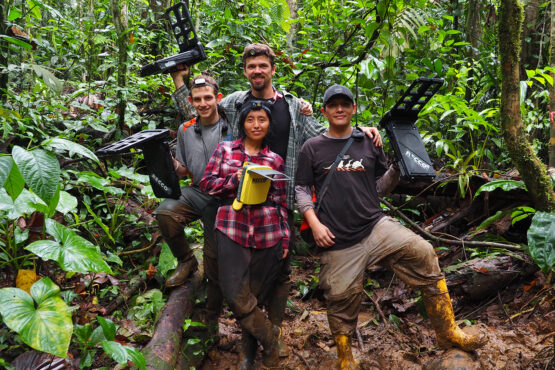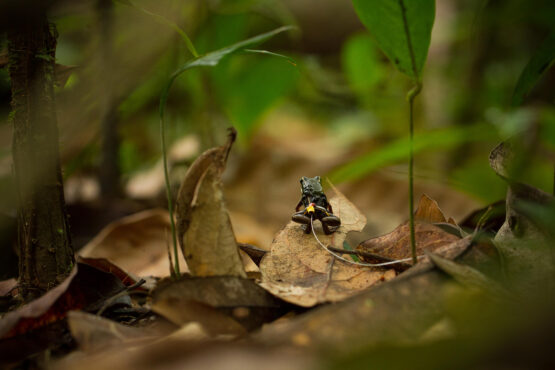Stanford researchers study frog spatial skills
Stanford-led study of poison frogs in tiny trackable pants tests two theories for sex differences in spatial skills.
Using tiny trackable pants and a “frog spa,” a Stanford University-led team has conducted the first known comparative study of how male and female amphibians navigate their surroundings.

Stanford biologist Lauren O’Connell holds a Diablito poison frog in her field site in Ecuador. (Image credit: Nora Moskowitz)
The research, co-led by Stanford biologists Andrius Pašukonis and Lauren O’Connell, tested two hypotheses for sex differences in spatial skills in field studies of three species of poison frogs in Ecuador and French Guiana.
Their findings challenge a long-standing explanation for why males tend to have better spatial skills than females, and provide evidence for a less-widely accepted hypothesis that posits sex hormones may influence spatial ability as a side effect. The research was published Nov. 15 in the journal eLife.
Spatial skills
The ability to navigate is a key trait that can differ between the sexes. In some species of rodents and in humans, males tend to navigate better than females, but the reason why is not fully known.
“In many mammals, males move more and have better-developed spatial skills,” explained O’Connell, who is an assistant professor of biology in the School of Humanities and Sciences. “Because sex differences in spatial abilities are not present in monogamous species, researchers proposed that it is an adaptive trait related to sex differences in mating strategies.”
This idea, called the adaptive specialization hypothesis, is the leading explanation for sex differences in mammalian behavior, even though tests of this theory are few and inconclusive, except for studies in rodents. A competing theory, called the androgen spillover hypothesis, states that male mammals have better spatial skills as a serendipitous side effect of their higher levels of androgens – a group of sex hormones that include testosterone.
Pašukonis and O’Connell wanted to test these hypotheses in a non-mammal species in the wild – something that had not been done before.
Poison frogs are perfect for this study because several closely related species have an exceptionally diverse range of spatial behaviors, and parental care and mating strategies. The variety of behaviors in poison frog species provided O’Connell and her team with a natural experiment to test the two theories for sex differences in spatial skills.
Frog parenting 101
Three species of poison frog in tracking belts. The brown Brilliant-Thighed poison frog (pictured left) has variable but mostly male parental care. The yellow and black-backed Dyeing poison frog (pictured center) has male care, and the rusty-red Diablito poison frog (pictured far right) has female care. (Image credit: Andrius Pašukonis)
Parenting is a complex affair for poison frogs. Males typically care for the young and navigate the rainforest to transport tadpoles from terrestrial clutches to pools of water on the forest floor or in plants. But some poison frog species have female parental care or flexible parental roles where either sex may transport and care for the young.
When females are the primary caregiver, they place tadpoles in small nurseries and supplement the tadpoles’ diet by feeding them their unfertilized eggs.
In this study, the researchers tracked the movements and tested the androgen levels of three species of poison frog – the brown Brilliant-Thighed poison frog, which has flexible but predominantly male parental care, the yellow and black-backed Dyeing poison frog that has male parental care, and the rusty-red Diablito poison frog, which has female parental care.
Tracking frogs in tiny pants
Spattered in vivid reds, sunny yellows, and rich browns, male and female poison frogs are eye-catching works of art. But following a frog – even if it is brightly colored – through a muddy rainforest is far from easy.

Pictured clockwise from left, Daniel Ari Shaykevich, Andrius Pašukonis, Shirley Jennifer “Jenni” Serrano Rojas, and Alejandro Marcillo-Lara pose in their study site in Ecuador. The researchers are holding tracking devices, called harmonic direction finders, that enable them to follow poison frogs wearing “frog pants.” (Image credit: Andrius Pašukonis)
To address this challenge, Pašukonis invented tiny, wire, Speedo-like pants that contain a radio tracking device.
“I became interested in studying the spatial behavior of tropical poison frogs during my PhD,” said Pašukonis, who is currently a postdoctoral scholar in O’Connell’s lab but invented the trackable pants as a doctoral student at the University of Vienna.
“Miniature tracking tags have been used on amphibians and other animals before but tracking tiny mobile frogs in the rainforest required reimagining the tag design and the tracking methods,” said Pašukonis. “One of the biggest challenges has been designing and perfecting a frog harness that can fit a frog as small as two centimeters (less than an inch)!”
His innovative design for “frog pants,” as the researchers call them, enabled the researchers to find frogs in the forest, estimate each frog’s home range size, and trace their path home after they were moved to test their spatial skills, O’Connell explained.
Before and after each frog was moved, the researchers assessed each frog’s androgen levels via a tiny frog spa, a glass container partially filled with water. Co-author Camilo Rodriguez, a graduate student at the University of Vienna and incoming Stanford postdoctoral researcher, adapted the method from a technique used to collect androgens from fish.
“The frogs sit in the bath for a half hour before and after translocation,” O’Connell explained. The frogs release hormones into the water and then, “we extract hormones from the bath water back at the lab.”
Traveling in tiny pants
Once the frogs are outfitted with trackable pants, relocated, and bathed, the researchers tracked the frogs to assess their navigational prowess. Co-authors Shirley Jennifer “Jenni” Serrano Rojas and Daniel Ari Shaykevich, two graduate students in the O’Connell lab, followed many of the frogs.

A Brilliant-Thighed poison frog wears a tracking belt that enables researchers to find and track its movements in the rainy and muddy rainforest of the Nature Reserve Les Nouragues in French Guiana. (Image credit: Andrius Pašukonis)
“The most striking and astonishing part of tracking these poison frogs was to see that they were making a straight trajectory toward home, this is especially true for the Brilliant-Thighed poison frogs,” said Serrano Rojas. “How could tiny frogs navigate the forest in this way? This is a question that still intrigues and amazes us.”
The poison frogs’ navigation and spatial memory were tested in the field by capturing more than 200 frogs and relocating them either 50 or 200 meters from their home territory. Frogs were considered to have successfully returned home if they completed at least 70 percent of the distance from the release site to the home center within three days if they were moved 50 meters, or within six days if moved 200 meters.
The researchers predicted the findings of their study would support the adaptive specialization hypothesis.
“We expected that in the species where dads care for offspring (Brilliant-Thighed and Dyeing poison frogs), the males would be better at spatial tasks, and in the species where moms cared for offspring (Diablito poison frogs), the females would be better at spatial tasks,” O’Connell said. “But that’s not what happened at all.”
Males of Brilliant-Thighed poison frogs navigated home faster and more accurately than females, as expected. But female Dyeing poison frogs navigated more accurately than males (the sex that provides parental care) when moved 200 meters away from home. Moreover, in Diablito poison frogs – the species where females have more complex spatial behavior and larger home ranges – females did not have better navigation than males.
The researchers found that male poison frogs – regardless of whether they provide parental care – generally are more explorative according to tracking done during the homing experiment and have androgen levels which is consistent with the androgen-spillover hypothesis.
“It was so instructive to see animals behaving outside of the lab in their natural habitats,” said Shaykevich. “It really hit home for me the importance of combining laboratory work with the study of animals out in the field.”
Competing interest: Lauren A O’Connell is a reviewing editor for eLife.
The researchers thank the staff of the CNRS Nouragues Ecological Research Station, Nouragues Nature Reserve, Fundación de Conservación Jocotoco, Reserva Canandé, Centro Jambatu de Investigación y Conservación de Anfibios, and Wikiri for logistic support and generously providing access to the study sites.
Postdoctoral scholar Marie-Therese Fischer is also a Stanford co-author on this study. Pašukonis is also affiliated with Vilnius University Life Sciences Center, Vilnius, Lithuania and Université Montpellier, Montpellier, France. O’Connell is a Faculty Fellow at Sarafan ChEM-H and member of the Wu Tsai Neurosciences Institute at Stanford, Stanford Bio-X, and the Maternal & Child Health Research Institute. Serrano-Rojas is also affiliated with Universidad Nacional de San Antonio Abad del Cusco, Cusco, Peru.
Additional co-authors are from the Technical University of Munich, Freising, Germany; Berchtesgaden National Park, Doktorberg, Berchtesgaden, Germany; the University of Jyväskylä, Jyväskylä, Finland; the University of Veterinary Medicine Vienna, Vienna, Austria; the University of Bern, Hinterkappelen, Switzerland; the University of Music and Performing Arts Graz, Graz, Austria; the University of Vienna, Vienna, Austria; Paul Sabatier University, Toulouse, France; Oklahoma State University; and the Centro Jambatu de Investigación y Conservación de Anfibios, Quito, Ecuador.
This study was supported by funding from the European Commission’s Horizon 2020 Framework Program, National Science Foundation, Association for the Study of Animal Behaviour, Austrian Science Fund, CNRS Nouragues Travel Grants, Analyses et Expérimentations pour les Ecosystèmes, New York Stem Cell Foundation, Academy of Finland, Wikiri, Saint Louis Zoo, and Agence Nationale de la Recherche.
To read all stories about Stanford science, subscribe to the biweeklyStanford Science Digest.
